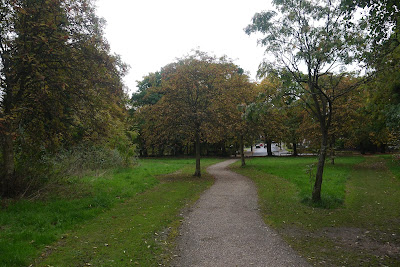I picked up a leaflet about Kings Norton Nature Reserve at an event a while ago, and filed it away to investigate at a later date. That date came on Saturday! If I was going to find myself a local patch, it had to meet a couple of criteria - it needed to be close to where I live, and it obviously had to have some potential for interesting birds. Kings Norton Nature Reserve is both of those things, being a 20-minute walk away from our house, and having a range of different habitats spread over a fair-sized area. Here is a helpful map from the Friends of Kings Norton Nature Reserve website:
 |
| Purple & blue = boundaries, green & yellow = paths. |
 |
| Open parkland with hedgerows and mature trees. |
 |
| Closed canopy maturing woodland. |
 |
| Small bits of reedbed. |
 |
| The River Rea path. |
 |
| Apparently there are some scrapes somewhere beyond here! |
 |
| Wychall Reservoir, which presumably has more water in it when there's been more rain. |
 |
| Young woodland along the River Rea. |
 |
| The River Rea. |
 |
| A bunch of planted Rowans, maybe good for Waxwings in winter? |
 |
| Horse paddocks. |
 |
| Merecroft Pool. |
 |
| Woodland and grassland. |
In total I saw or heard 30 bird species on my 2-hour walk around. The highlights included:
- 4 Fieldfare in the open parkland of the westernmost area of the Rea Valley.
- A Skylark flyover, heard from the same area.
- As expected for the time of year, Jays aplenty caching their precious acorns.
- At least 24 Redwings.
- A Kingfisher in Wychall Reservoir.
- A Water Rail skulking around in the undergrowth at the north end of Merecroft Pool.
- Grey Wagtail flying over at the south end of Merecroft Pool.
- A mixed tit flock in the same area, with Blue, Great, Coal and Long-tailed Tits plus Goldcrest.
I also spotted a few plants:
 |
| I think this is some kind of Aster, but I'm not sure which.... |
 |
| Guelder-rose (Viburnum opulus). |
 |
| Devil's-bit Scabious (Succisa pratensis). |
FULL BIRD LIST
Blackbird
|
Goldfinch
|
Mute Swan
|
Black-headed Gull
|
Great Tit
|
Nuthatch
|
Blue Tit
|
Greenfinch
|
Redwing
|
Bullfinch
|
Grey Wagtail
|
Robin
|
Carrion Crow
|
Jay
|
Skylark
|
Coal Tit
|
Kingfisher
|
Song Thrush
|
Coot
|
Long-tailed Tit
|
Tufted Duck
|
Dunnock
|
Magpie
|
Water Rail
|
Fieldfare
|
Mallard
|
Woodpigeon
|
Goldcrest
|
Moorhen
|
Wren
|
Its a gem isn't it. I joined their dawn chorus walk in May 2 years ago, heard loads of birds. Have you ever explored Woodbrooke? I volunteer there and am constantly delighted by the birds I hear as I work
ReplyDeleteI'm looking forward to going on their next guided walk at the end of the month. Where is Woodbrooke - is that the Quaker Centre on the Bristol Road? I haven't got further than the park with the boating pond on Woodbrooke Road/Bournville Lane. There is so much nice green space in south Birmingham :o)
ReplyDeleteYes it's the quaker conference centre. People do wander in from the entrance near the yachting pool but if you go through the main entrance on bristol road and pop into reception they are usually happy to give permission to look round
DeleteI forgot to mention parts of woodbrooke grounds are designated a Local Wildlife Site. (formerly a SINC)
DeleteGreat, thanks - I'll have to check it out.
Delete